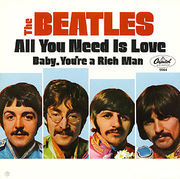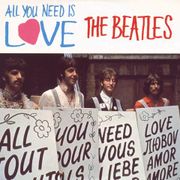All You Need Is Love
| "All You Need Is Love" | |||||||||||||||||||||||||||||||||||
|---|---|---|---|---|---|---|---|---|---|---|---|---|---|---|---|---|---|---|---|---|---|---|---|---|---|---|---|---|---|---|---|---|---|---|---|
 US single |
|||||||||||||||||||||||||||||||||||
| Single by The Beatles | |||||||||||||||||||||||||||||||||||
| B-side | "Baby, You're a Rich Man" | ||||||||||||||||||||||||||||||||||
| Released | 7 July 1967 | ||||||||||||||||||||||||||||||||||
| Format | 7" | ||||||||||||||||||||||||||||||||||
| Recorded | 14 and 25 June 1967, Olympic and EMI studios, London |
||||||||||||||||||||||||||||||||||
| Genre | Rock | ||||||||||||||||||||||||||||||||||
| Length | 3:57 | ||||||||||||||||||||||||||||||||||
| Label | Parlophone | ||||||||||||||||||||||||||||||||||
| Writer(s) | Lennon/McCartney | ||||||||||||||||||||||||||||||||||
| Producer | George Martin | ||||||||||||||||||||||||||||||||||
| Certification | Gold (RIAA)[1] | ||||||||||||||||||||||||||||||||||
| The Beatles singles chronology | |||||||||||||||||||||||||||||||||||
|
|||||||||||||||||||||||||||||||||||
|
|||||||||||||||||||||||||||||||||||
"All You Need Is Love" is a song written by John Lennon and credited to Lennon/McCartney. It was first performed by The Beatles on Our World, the first live global television link. Watched by 400 million in 26 countries, the programme was broadcast via satellite on 25 June 1967.[2] The BBC had commissioned the Beatles to write a song for the United Kingdom's contribution. Rolling Stone magazine ranked it at #362 in their 500 greatest songs of all time.[3]
Contents |
Release
The Beatles were asked to come up with a song containing a simple message to be understood by all nationalities. "It was an inspired song and they really wanted to give the world a message," said Brian Epstein. "The nice thing about it is that it cannot be misinterpreted. It is a clear message saying that love is everything."[4] According to journalist Jade Wright, "Lennon was fascinated by the power of slogans to unite people and never afraid to create art out of propaganda. When asked in 1971 whether songs like Give Peace a Chance and Power to the People were propaganda songs, he answered: 'Sure. So was All You Need Is Love. I'm a revolutionary artist. My art is dedicated to change.'"[4]
The day before the Our World broadcast, the Beatles decided that the song should be their next single. Released in the UK on 7 July 1967, it went straight to number one and remained there for three weeks. It was similarly successful in the United States after its release on 17 July, reaching number one for a week. It was also included on the American LP version of Magical Mystery Tour in November.[5]
The interviews on The Beatles Anthology documentary series reveal that Paul McCartney and George Harrison were unsure whether the song was written for Our World. However, George Martin and Ringo Starr assert it was. When asked, McCartney replied:
"I don't think it was written specially for it. But it was one of the songs we had. [...] It was certainly tailored to it once we had it. But I've got a feeling it was just one of John's songs that was coming there. We went down to Olympic Studios in Barnes and recorded it and then it became the song they said, 'Ah. This is the one we should use.' I don't actually think it was written for it."[6]
Live broadcast
For the broadcast, the Beatles were (except for Starr) seated on stools, accompanied by a small studio orchestra. They were surrounded by friends and acquaintances seated on the floor, many of whom were among the leading stars of the British pop scene, who sang with the refrain during the fade-out, including Mick Jagger, Marianne Faithfull, Keith Richards, Keith Moon, Eric Clapton, Graham Nash, Pattie Harrison, Jane Asher, Mike McCartney, Gary Leeds and Hunter Davies.[7]
The performance was not completely live: The Beatles, the orchestra, and guests were overdubbing onto a pre-recorded rhythm track mainly consisting of piano, harpsichord, drums, and backing vocals. Canadian musician Harry Currie was engaged as a backup vocalist in the original recording session at Abbey Road Studios in 1966. The full Our World segment opens with the band and company listening to the raw backing track, as commentator Steve Race explained the process in voiceover. The live overdubs seem to include not only lead vocals, orchestra, and the improvised call-and-response, but also bass guitar, Harrison's guitar solo, and a second drum track — which seems to go out of time with the original track during the first few bars. At the beginning of the song, under "La Marseillaise," a tambourine is shaken, but this was mixed out and replaced with a drum roll before the single was released.
Lennon, affecting indifference, was said to be nervous about the broadcast, given the potential size of the international TV audience. Dissatisfied with his singing, he re-recorded the solo verses for use on the single.[7][8] Starr also overdubbed drums before the single was released,[8] fixing the aforementioned timing problems and adding the drum roll.
The programme was broadcast in ‘black-and-white’ (colour television had yet to commence broadcasting in Britain and most of the world). The Beatles' footage was colourised, based on photographs of the event, for The Beatles Anthology documentary.
Structure
Because of the worldwide broadcast, the song was given an international feel, opening with the French National anthem "La Marseillaise" omitting the first note, and including excerpts of other pieces during the long fade-out, including "two-part Invention #8 in F" by Johann Sebastian Bach (transposed to G and played on 2 piccolo trumpets), "Greensleeves" (played by the strings), Glenn Miller's "In the Mood" (played on a saxophone), one of the Beatles' seminal hits (particularly in Great Britain and the United States), "She Loves You" (ad libbed by Lennon and McCartney[9]), the chorus of "Sgt. Pepper's Lonely Hearts Club Band", and Jeremiah Clarke's "Prince of Denmark's March" lilting off at the end. Many sources, including Beatles' producer George Martin, have misremembered or misidentified the Bach quote as being from the "Brandenburg Concerto No. 2". Lennon can also be heard scatting what sounds like the title of "Yesterday". At the end of each chorus a brassband plays the "ratatatata" from Chanson D'Amour
The structure of the song is complex. The main body (the verse) is in a 7/4 time signature with two measures of 7/4, one of 8/4, then back to 7/4 with the intro background vocals repeatedly singing "Love, love, love", over the top of which enter Lennon's lyrics:
| “ | There's nothing you can do that can't be done Nothing you can sing that can't be sung Nothing you can say but you can learn how to play the game It's easy |
” |
By contrast, the chorus is simple: "All you need is love", in 12/8 time repeated against the horn response but, each chorus has only seven measures as opposed to the usual eight, and the seventh is 6/4, then back to the verse in 7/4.
"All You Need Is Love" remains one of only two songs (along with Pink Floyd's "Money" from 1973) written in 7/4 time to reach the top 20 in the United States. (Peter Gabriel's Solsbury Hill is also written in 7/4 time)
In the film Yellow Submarine (1968), the second verse as well as the instrumental are deleted. Also, the last choruses are switched, the "all together now", and "everybody" coming first before the last group of choruses.
Personnel
- John Lennon: lead and background vocals, harpsichord and banjo.
- Paul McCartney: bass, double bass and background vocals.
- George Harrison: lead guitar, violin and background vocals.
- Ringo Starr: drums and percussion.
- George Martin: piano, orchestration and production.
- Session musicians played strings, brass, woodwind and accordion as conducted by Mike Vickers.
- Friends and studio people made hand claps and sang background vocals (including Mick Jagger, Keith Moon, Canadian vocalist Harry Currie, and many others).[7]
Cover versions
| Group or artist’s name | Release date | Album title | Additional information |
|---|---|---|---|
| The 5th Dimension | 1971-10 | The 5th Dimension/Live![10] | |
| Eddie Chacon | 1987 | 12" single[11] | Columbia 4406930 |
| Echo & the Bunnymen | 1988 | New Live and Rare[12] | This version is also included on Crystal Days 1979-1999; they also released a live cover as a bonus track on the 2003 re-release of their 1985 album Ocean Rain. |
| Tears for Fears | 1990 | Going to California (Live DVD) | Orzabal changed some of the lyrics and incorporated the phrase "Raoul and the Kings of Spain" which would go on to be the title of a future album. |
| Anything Box | 1991-05 | Worth[13] | |
| Tom Jones | 1993-01 | single[14] | |
| Ferrante & Teicher | 1993-01-29 | The Greatest Love Songs of All[15] | |
| The Undead | 1998-07 | Till Death[16] | |
| Lynden David Hall | 2003-11-11 | Love Actually[17] | |
| Dana Fuchs & Jim Sturgess | 2007 | Across the Universe (film) | |
| Noel Gallagher | 2009 | The Dreams We Have as Children (Live for Teenage Cancer Trust) |
Notes
- ↑ RIAA 2009.
- ↑ The Beatles Official Website 2009.
- ↑ Rolling Stone 2004.
- ↑ 4.0 4.1 Wright 2009.
- ↑ The Beatles Bible 2008.
- ↑ The Beatles Anthology 1995.
- ↑ 7.0 7.1 7.2 Lewisohn 1988, p. 120.
- ↑ 8.0 8.1 Unterberger 2006, p. 178.
- ↑ What Goes On 2009.
- ↑ Torreano.
- ↑ vinylrecords.co.uk.
- ↑ Ankeny 2009.
- ↑ Cooper 2009.
- ↑ BBC Wales 2009.
- ↑ AOL Music 2009a.
- ↑ Allmusic 2009.
- ↑ Phares 2009.
References
- "'All You Need Is Love' Lyrics– Ferrante & Teicher". AOL Music. 2009a. http://music.aol.com/song/all-you-need-is-love/162519. Retrieved 27 November 2009.
- "Bach Meets the Beatles – John Bayless". AOL Music. 2009b. http://music.aol.com/album/bach-meets-the-beatles/48575. Retrieved 27 November 2009.
- "Overview of Till Death by the Undead". Allmusic. 2009. http://allmusic.com/cg/amg.dll?p=amg&sql=10:wvfwxqtjldae. Retrieved 27 November 2009.
- Ankeny, Jason (2009). "Review of New Live and Rare: Echo & the Bunnymen". Allmusic. http://www.allmusic.com/cg/amg.dll?p=amg&sql=10:dxfixqt0ldte~T1. Retrieved 27 November 2009.
- "Tom Jones discography". BBC Wales. 2009. http://www.bbc.co.uk/wales/music/sites/genres_artists/rock_pop/tom_jones_discography.shtml. Retrieved 27 November 2009.
- The Beatles Anthology. 1995. Event occurs at Episode 7.
- "All You Need Is Love". The Beatles Bible. 2008. http://www.beatlesbible.com/songs/all-you-need-is-love/. Retrieved 12 October 2008.
- "The Our World TV Show". The Beatles Official Website. 2009. http://www.thebeatles.com/#/article/The_Our_World_TV_Show. Retrieved 27 November 2009.
- Cooper, William (2009). "Review of Worth by Anything Box". Allmusic. http://www.allmusic.com/cg/amg.dll?p=amg&sql=10:fcfuxqu5ldhe. Retrieved 27 November 2009.
- Lewisohn, Mark (1988). The Beatles Recording Sessions. New York: Harmony Books. ISBN 0-517-57066-1.
- Phares, Heather (2009). "Review of Love Actually - Original Soundtrack". Allmusic. http://www.allmusic.com/cg/amg.dll?p=amg&sql=10:jvfoxqtaldje. Retrieved 27 November 2009.
- "RIAA Gold & Platinum Searchable Database - The Beatles Gold Singles". RIAA. 2009. http://riaa.com/goldandplatinumdata.php?resultpage=1&table=SEARCH_RESULTS&action=&title=&artist=The%20Beatles&format=SINGLE&debutLP=&category=&sex=&releaseDate=&requestNo=&type=&level=&label=&company=&certificationDate=&awardDescription=Platinum&catalogNo=&aSex=&rec_id=&charField=&gold=&platinum=&multiPlat=&level2=&certDate=&album=&id=&after=&before=&startMonth=1&endMonth=1&startYear=1958&endYear=2009&sort=Artist&perPage=25. Retrieved 20 July 2009.
- "The RS 500 Greatest Songs of All Time". Rolling Stone. 9 December 2004. http://www.rollingstone.com/news/coverstory/500songs/page/4. Retrieved 26 November 2009.
- Torreano, Bradley. "Review of The 5th Dimension/Live!! by the 5th Dimension". Allmusic. http://www.allmusic.com/cg/amg.dll?p=amg&sql=10:avfexqt5ld6e.
- Turner, Steve (2005). A Hard Day's Write: The Stories Behind Every Beatles Song (3rd ed.). New York: Harper Paperbacks. ISBN 0-06-084409-4.
- Unterberger, Richie (2006). The Unreleased Beatles: Music & Film. Hal Leonard Corporation. ISBN 9780879308926.
- "Extras - All You Need Is Love / She Loves You". What Goes On. 2009. http://wgo.signal11.org.uk/html/extras/aynil.htm. Retrieved 26 November 2009.
- Wright, Jade (2009). "Rock of Ages". BNET. http://findarticles.com/p/news-articles/liverpool-echo-england/mi_7971/is_2009_July_25/rock-ages/ai_n35509459/. Retrieved 27 November 2009.
- "Vinyl Records UK Catalog". http://www.vinylrecords.co.uk/page41.html.
External links
- Alan W. Pollack's Notes on "All You Need Is Love"
- CoverTogether: "All You Need is Love" Cover Versions
| Preceded by "A Whiter Shade of Pale" by Procol Harum |
UK Singles Chart number one single 19 July 1967 (three weeks) |
Succeeded by "San Francisco (Be Sure to Wear Flowers in Your Hair)" by Scott McKenzie |
| Preceded by "Light My Fire" by The Doors |
Billboard Hot 100 number one single August 19, 1967 (one week) |
Succeeded by "Ode to Billie Joe" by Bobbie Gentry |
|
||||||||||||||||||||||||||||||||||||||||||||||||||||||||||||||||||||||||||||||||||||||||||||||||||||||||||||||||||||||||||||||||||||||||||||||||||||||||||||||||||||||||||||||||||||||||||||||||||
